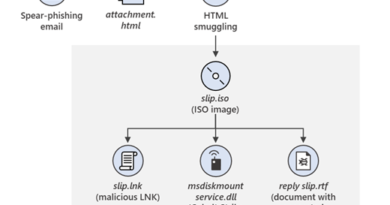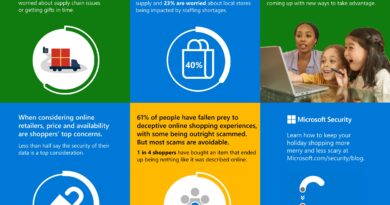The state of apps by Microsoft identity: Azure AD app gallery apps that made the most impact in 2020
2020 was an unprecedented year, to say the least. The COVID-19 global pandemic drastically changed how we work, learn, and collaborate. Organizations had to find new ways to connect and maintain productivity while providing secure access to critical apps and resources. Our own Microsoft services, like Teams, served as the lifeline for remote and hybrid work and learning during the pandemic—growing rapidly from 44 million daily active users in March 2020 to 115 million daily active users this past October. But we know that businesses need many tools and apps to succeed, and our commitment is to ensure that solutions work seamlessly and securely across platforms and extend to all clouds and apps.
Recently, we analyzed enterprise cloud app usage and took a deeper look at how and what applications organizations are securing with Azure Active Directory (Azure AD). In our analysis, we looked at organizations’ application usage within our Azure AD app gallery, excluding Microsoft applications such as Azure, Dynamics 365, Office 365, and Teams. Our Azure AD app gallery enables organizations to quickly secure and manage apps of all types and includes thousands of pre-integrated apps. We’re seeing customers of all sizes integrate all their apps with Azure AD to give their workforce a more convenient and secure experience. Read on for insights into how app usage shifted in 2020 compared to the years prior.
The rise of security and collaboration apps to enable remote work
The challenges of 2020 forced leaders to rethink their priorities to ensure their teams can securely access apps from anywhere, anytime. The statistics reflect this. For example, the number of monthly active users of Azure AD app gallery apps has increased 109 percent year-over-year. And last year, when Microsoft surveyed 800 business leaders about their views of the pandemic threat landscape, they listed “Providing secure remote access to resources, apps, and data” as their number one challenge.
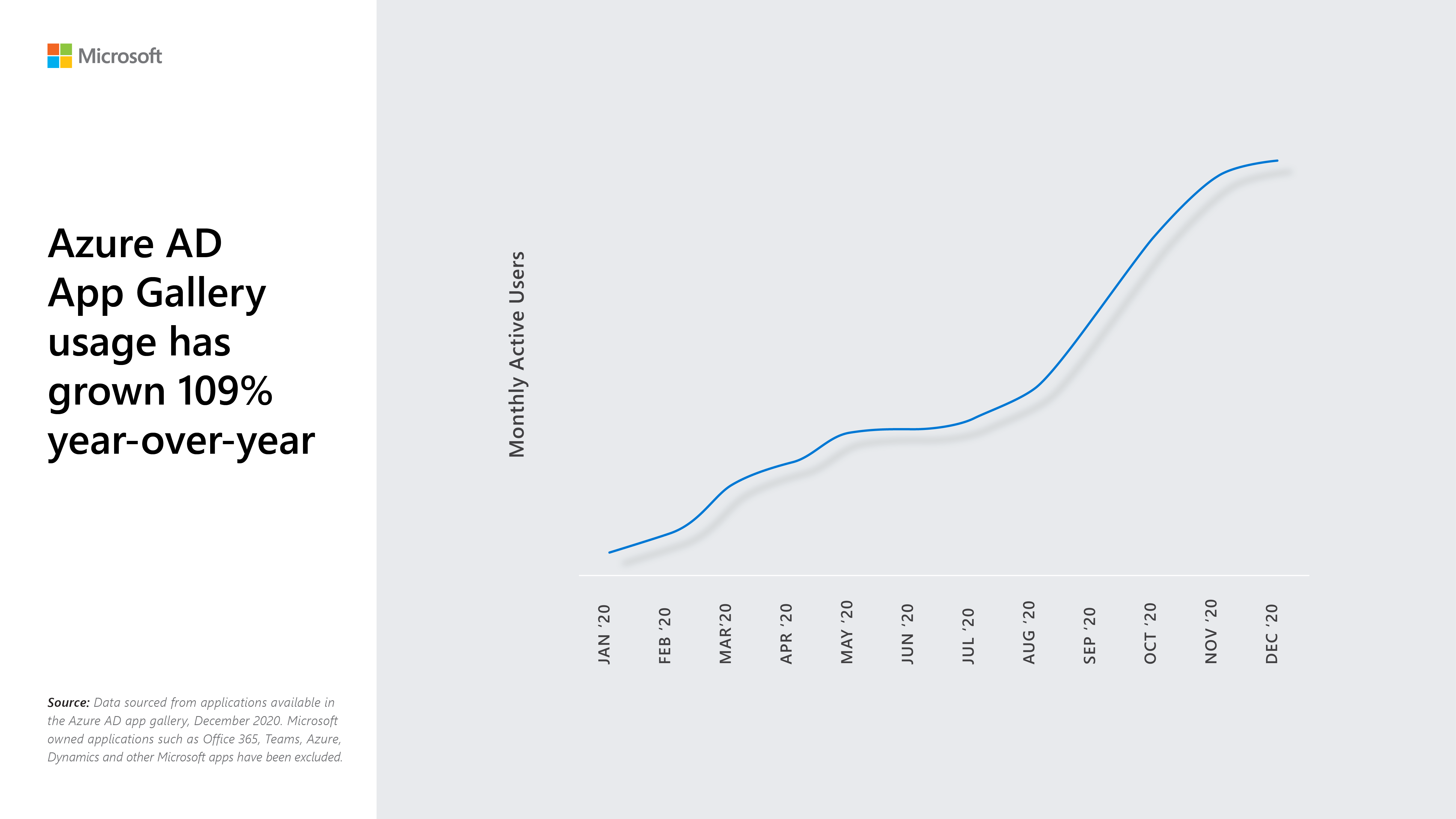
It’s no surprise, then, that apps and services that help ensure secure, remote access to on-premises, and cloud resources grew tremendously last year. Organizations have recognized that remote access to all apps including legacy, on-premises apps have become critically important in the new way of work. Security tools like Citrix ADC, Palo Alto Networks Prisma Access, and Zscaler Private Access, which help employees securely access any app regardless of location, have become business-critical, making them some of the fastest-growing applications in our app gallery this past year.
In addition to increasing investments in the security space, communication, and collaboration apps have been instrumental to ensure business continuity. We recognize that securing any app is a team effort, so we work closely with app providers of all types to integrate with Azure AD, even Microsoft competitors. Apps like Cisco Webex, Google Cloud / Google Workspace, Workplace from Facebook, and Zoom are some of the top apps Azure AD secures to help organizations maintain productivity while helping people feel more connected.
We’ve also continued to see a few apps consistently in our most popular apps list. Human Resource apps like SAP SuccessFactors and Workday and IT Service Management apps like ServiceNow continue to see widespread usage among our customers in 2020.
The top apps of 2020
The global pandemic clearly had an impact on which apps were used the most. Companies shifting to remote work improved productivity with apps that strengthened communication, collaboration, and security.
For the first time, security apps like Palo Alto Networks Prisma Access and Zscaler Private Access made their way to the top 15 apps by monthly active users. Other newcomers to the top 15 apps list include collaboration and communication apps; Workplace from Facebook and Zoom. Zoom not only made its 2020 debut within the top 15 on this list, it catapulted to number 5.
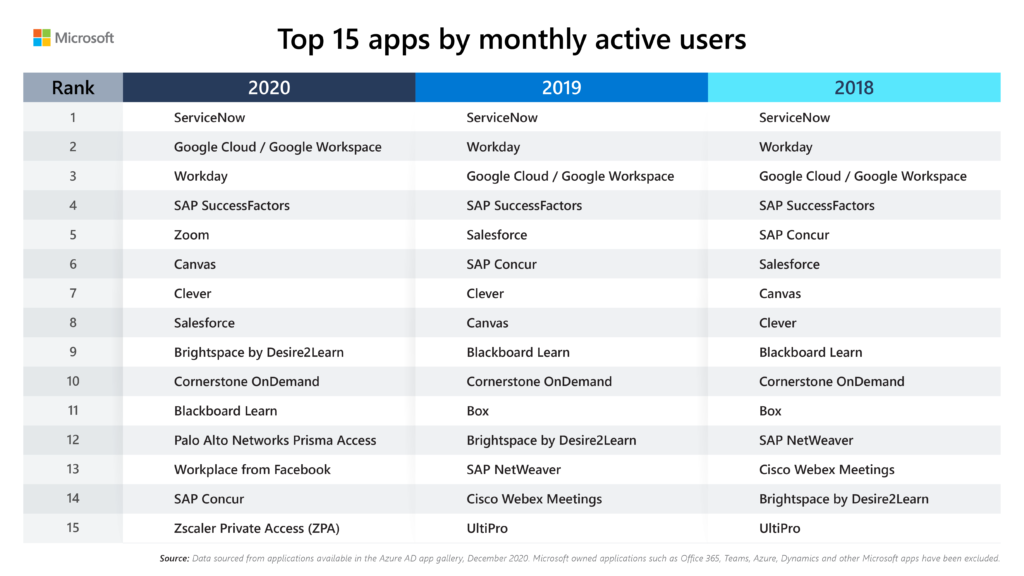
ServiceNow continues to lead in monthly active users for the third year in a row. Google Cloud / Google Workspace, SAP SuccessFactors, and Workday have maintained their leading ranks through the years, as organizations of all sizes need HR, IT Service Management, and general productivity applications.
From Q1 2020 to Q2 2020, as the global pandemic hit, many of these top apps accelerated in usage to help provide secure remote access for users and to help manage their digital workflows.
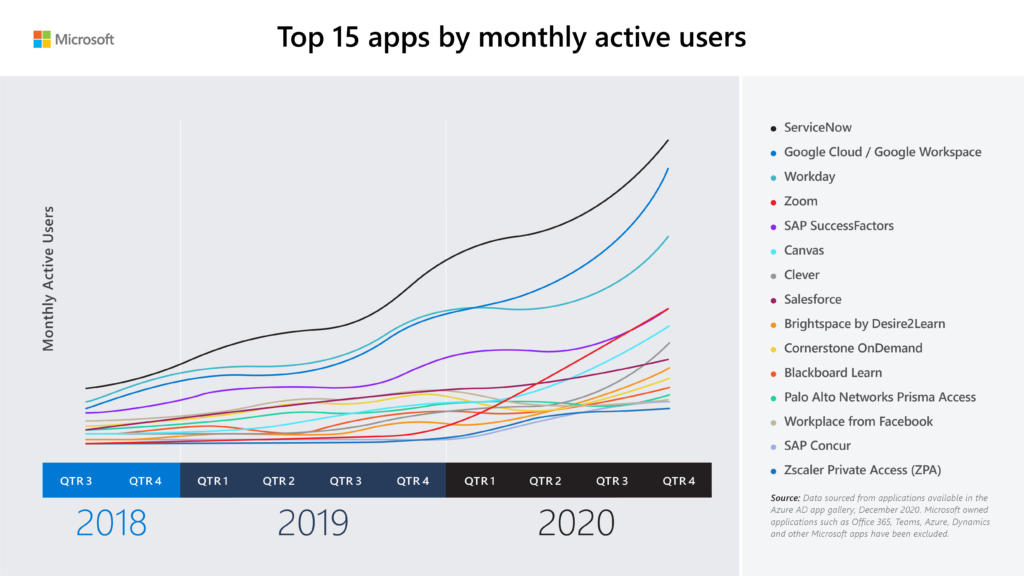
We also noticed some subtle differences when comparing the most popular apps by monthly active users with the most popular apps by the number of organizations. Popularity by the number of organizations looks at the apps most used among our customers. With organizations relying more heavily on video conferencing, Zoom made the jump from number 10 in 2018 to number 1 in 2020, pushing list leaders like Google Cloud / Google Workspace, and Salesforce from the top two spots.
In addition to Zoom, KnowBe4 Security Awareness made its way to the top 5 apps in 2020. It rose from number 12 in 2018 to number 8 in 2019, increasing steadily in usage from the beginning of quarter two 2020 to the end of the year, stressing the importance of security training and awareness within the workforce.
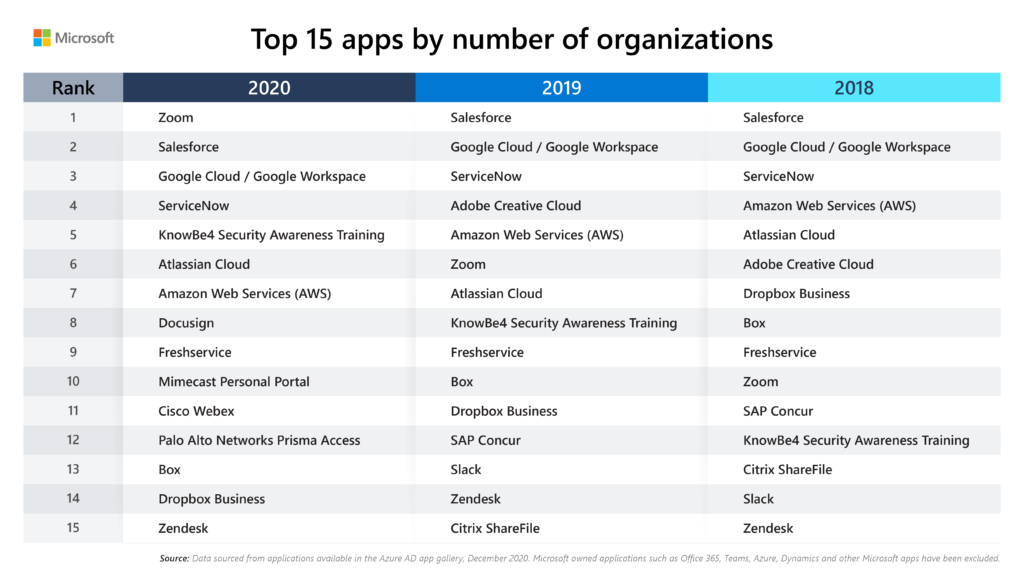
Cisco Webex, DocuSign, Mimecast Personal Portal, and Palo Alto Networks Prisma Access made their first appearance on this list in 2020, reinforcing the shifts we’ve seen throughout our analysis.
Unlike the security and collaboration apps that topped the list, apps like SAP Concur, a travel and expense management service, dropped off the top 15 list. Due to travel restrictions, those used to traveling regularly for work have swapped out face-to-face meetings for virtual calls from home.
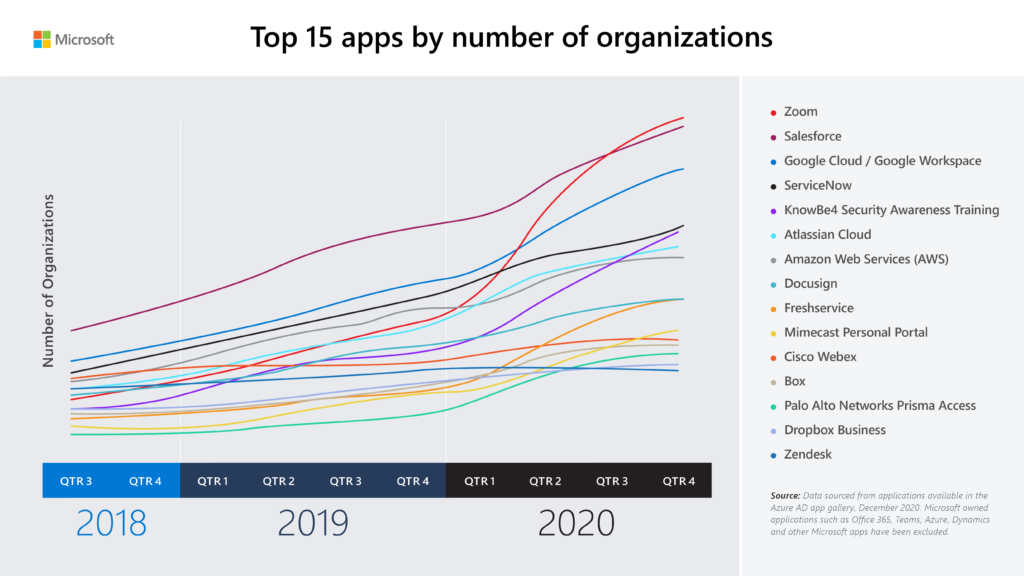
The most popular apps by organization size
When we analyzed the most popular apps used based on organization size, we found several apps commonly deployed in organizations of all sizes: Google Cloud / Google Workspace, Salesforce, and Zoom.
In contrast, deployment of HR and IT service management apps, necessary to ensure business continuity during the pandemic, differ based on the organization size. These apps have not only helped enable remote onboarding and offboarding, but they’ve also helped IT teams fulfill employee requests for applications, devices, or services.
While enterprise and mid-market organizations use HR apps such as SAP SuccessFactors and Workday, small businesses commonly use BambooHR. And HR apps like UltiPro and Cornerstone OnDemand are used more by mid-market businesses.
Enterprise and mid-market organizations regularly deploy the IT service management app ServiceNow, while small businesses predominantly use Freshservice.
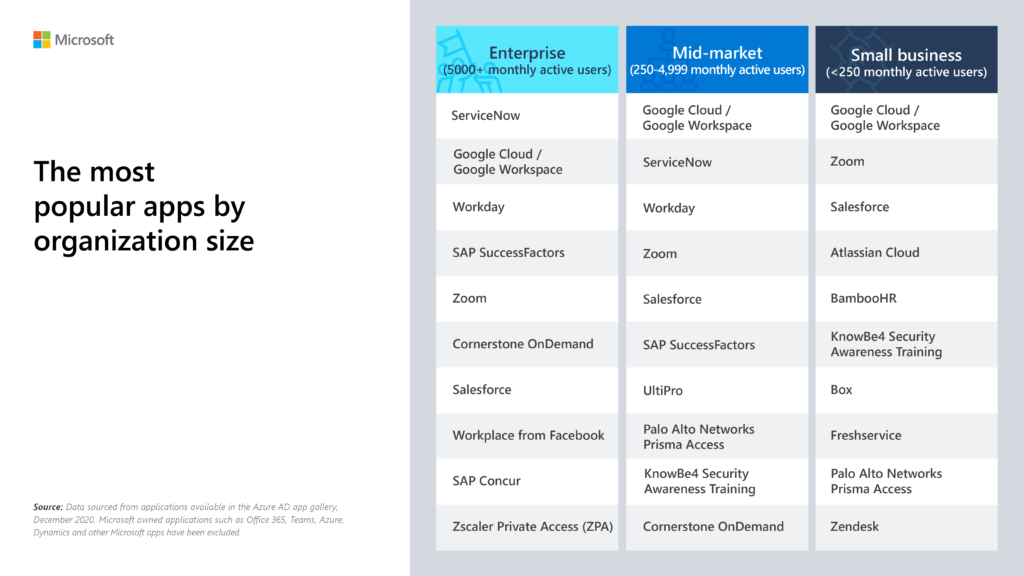
The most popular apps by industry
The same broad trends and app usage apply to the most popular apps by industry. Apps like Google Cloud / Google Workspace, Salesforce, ServiceNow, Workday, and Zoom are popular across all industries. Security, collaboration, and workflow management were priorities this past year despite the differences between each industry.
One industry, education, had a distinct set of popular apps, with apps like Brightspace, Canvas, and Clever ranking in the top five. These learning management systems helped schools and institutions adapt to remote learning and became central hubs for digital instruction this past year.
For shift-based industries that rely on frontline workers, like Retail and Healthcare, Kronos is a popular app to help with workforce management activities like employee scheduling.
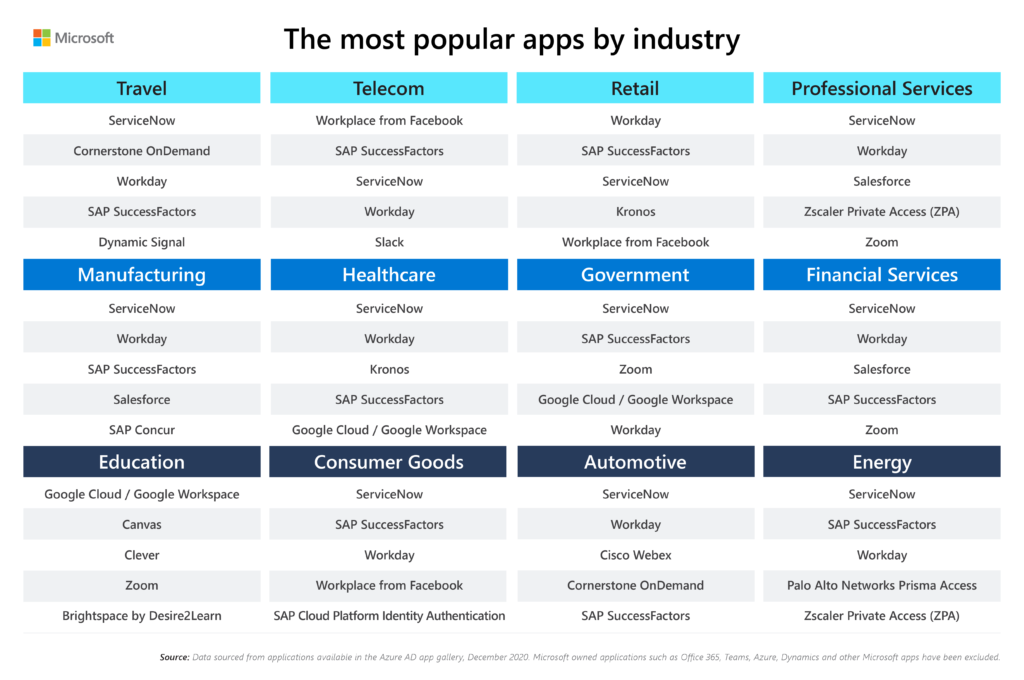
The most popular apps by category
This year, we also analyzed the most popular apps across app categories based on monthly active users. We looked at the top five apps across 10 app categories, ranging from education apps to security apps to IT service management apps, as summarized in the table below.
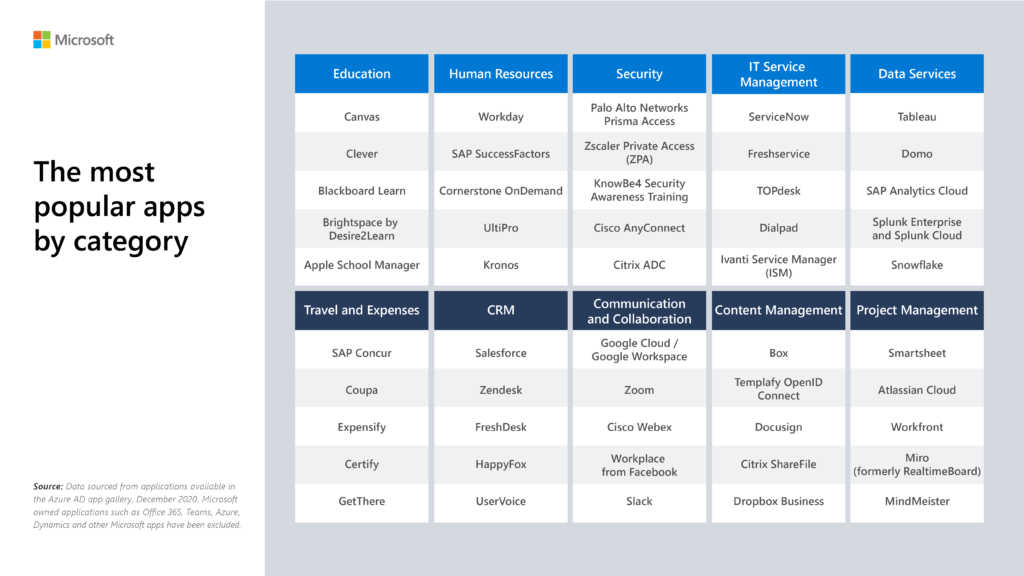
2020’s fastest-growing apps
Apps that help employees with secure remote work are not only some of the most popular but also among the fastest-growing. Half of the top 10 fastest growing apps in 2020 were security-focused. Apps from our secure hybrid access partnerships—Citrix ADC, Palo Alto Networks Prisma Access, and Zscaler Private Access—which enable customers to access legacy and on-premises apps, have also grown quickly. Other security apps include Cisco Umbrella, the fastest growing app this past year, and BeyondTrust Remote Support.
Zoom saw extraordinary growth in 2020. Its place as the third fastest-growing app this past year is particularly impressive given it was already popular and widely used. Data management and analytics solutions grew quickly this year too. Snowflake and SAP Analytics Cloud became the eighth and ninth fastest-growing apps, respectively.
This past year also saw Amazon Business become one of the fastest-growing apps. Amazon Business is a marketplace that simplifies the purchasing process and helps get products into the hands of organizations. The pandemic accelerated online shopping for consumers and it’s no different for businesses. Businesses have shifted their purchasing and procurement to online with Amazon Business becoming the fifth fastest growing app in 2020.
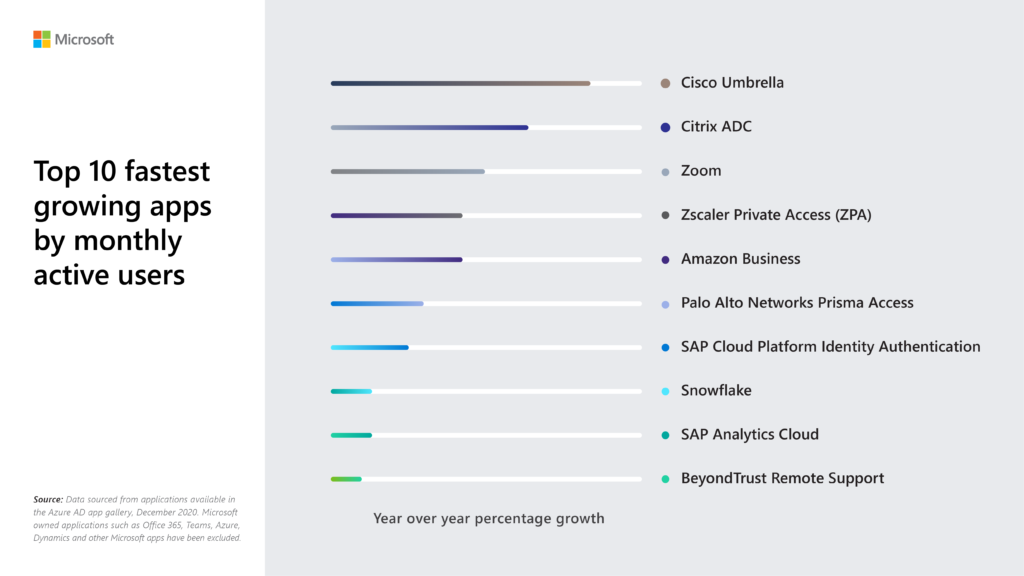
Secure digital transformation
Whether we look at the most popular apps by monthly active users, the number of organizations, industries, or customer type, or we look at the fastest growing apps of 2020, investment in security is an undeniable trend. The pandemic has both accelerated digital transformation timelines and increased the need for advanced security that organizations can rely on to provide secure access to their users wherever they may be working.
We’ve seen more users turn on security capabilities like multi-factor authentication (MFA)—the number of monthly active users utilizing MFA with Azure AD has grown 150 percent year-over-year. Passwordless technology also experienced a breakthrough year. Passwordless usage in Azure AD went up by more than 50 percent for Windows Hello for Business, passwordless phone sign-in with Microsoft Authenticator, and FIDO2 security keys.
Our own Azure AD App Proxy service, which helps organizations with remote access to critical on-premises apps, also experienced huge growth this past year. From February to March, the number of monthly active users spiked by roughly 60 percent as the global pandemic started to take hold. Since then, the number of monthly active users has continued to rise, increasing by roughly 100 percent year-over-year. Thanks to Azure AD App Proxy, organizations have been able to quickly provide secure, remote access to mission-critical apps that reside on-premises or use legacy authentication protocols like HTTP or header-based.
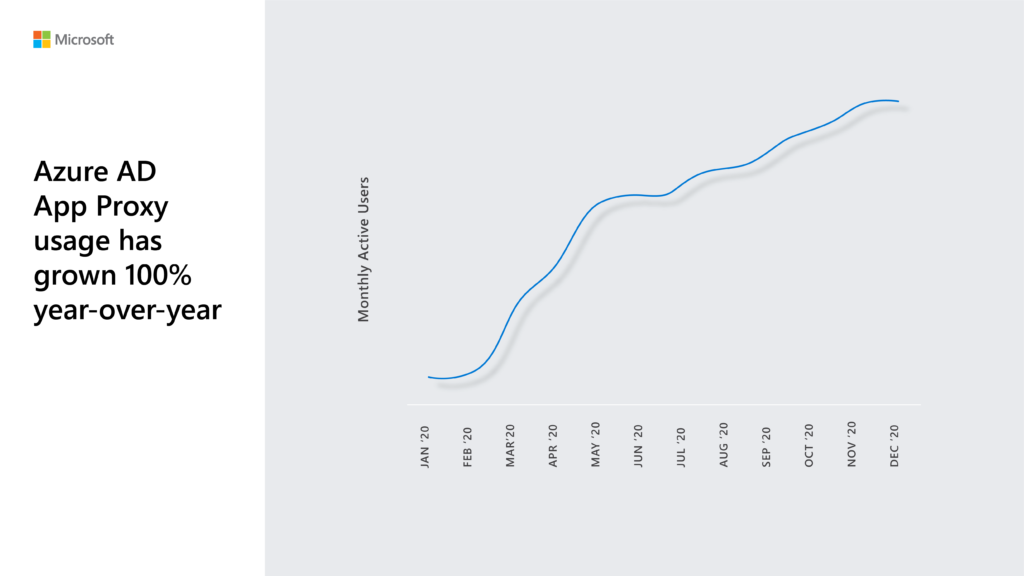
That’s a wrap on 2020
Users, organizations, and industries alike are investing in improving security and collaboration. Cloud-based apps that provide secure access and reliable communication have become a vital part of organizations’ day-to-day operations.
App adoption is growing, and the changing digital landscape has changed the way people work. From security apps like Palo Alto Networks Prisma Access to education apps like Blackboard Learn and communication apps like Zoom or Teams, people are relying more heavily on cloud apps to get their work done. We expect these trends to continue past 2020 as security remains a top priority and remote work continues to require advanced communication and collaboration capabilities. In the wake of 2020, companies will continue to evaluate the cultural and business impact of the shift to remote work and to try to understand where that shift will take them in 2021.
Connecting all of your apps to Azure AD can help safeguard and streamline access while simplifying management and reducing costs. In fact, Forrester estimates that customers can gain a 123 percent return on investment by secure all apps with Azure AD. To learn how to help your employees working from home remain productive, visit our secure remote work resources or read the Top 5 ways Azure AD can help you enable remote work. We hope you’ve enjoyed this year’s app trends data report, which you can also download here, and we look forward to seeing you next year.
Microsoft takes privacy seriously. We remove all personal data and organization-identifying data, such as company name, from the data before using it to produce reports. We never use customer content such as information within an email, chat, document, or meeting to produce reports. Application usage and trend data in this report was analyzed based on applications available in the Azure AD app gallery. We excluded Microsoft owned applications from the data such as Office 365, Teams, Azure, Dynamics, LinkedIn, GitHub, and other Microsoft applications from this report. The report includes data from December 31, 2018, to December 31, 2020.
READ MORE HERE

